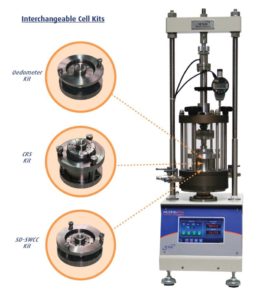
Description
The One-dimensional Consolidation test (ASTM D2435/D2435M – 11) is used to determine the consolidation characteristics of low-permeability soils. Tests are performed on specimens prepared from undisturbed samples. Data obtained from these tests, together with classification data and a knowledge of the soil’s loading history, enable estimates to be made of the behavior of foundations under loading.
The swell test (ASTM D4546-14e1) is a simple test that is routinely employed in geotechnical engineering practice to assess quantitatively the expansive potential of undisturbed or remolded clay soils, and to guide the design of surface structures on these soils.
ACONS Pro Multi-Purpose Consolidation frame is a new concept in soil testing, enabling 3 different kinds of automated tests to be performed in the same frame:
- Oedometer testing (Consolidation Cell or MPCC kit)
- Constant Rate of Strain (CRS) testing
- Stress Dependent Soil Water Characteristic Curve (SD-SWCC) testing
This is achieved using a multi-purpose consolidation cell and three separate cell kits up to 70 mm (2.75 in.) diameter, with ethernet or USB Interface from the frame to control using Clisp Studio software.
The objective of a swelling pressure test (ASTM D4546-14e1) on soil is to determine the swelling pressure of expansive soil when it is not allowed to undergo any volume change.
Testing Ranges
- Maximum Frame Capacity: 15kN (3372 lbf)
- Resolution: 0.1 N (0.0225 lbf)
- Accuracy: 0.15% FRO
- Adjustable Displacement Rate: 0.0001 – 10.0000 mm/min (0.0001 – 0.3937 inches/min)
- Fast Approach Speed: 40.0000 mm/min (1.5750 inches/min)
- Dimensions (W x D x H): 280 x 320 x 930 mm (11″ x 12.75″ x 36.6″)
- Weight: 31 kg (68 lb)
Material Properties
Consolidation Properties
- Preconsolidation pressure, σ’p
- The overburden stress that marks the boundary between NC (loose) and OC (dense) deformation response of a soil to loading
- Usually indicative of past pressure experienced by the soil from glaciers or eroded layers
- Recompression Index, CR = Δe/Δlogσ’v
- Indicates the behavior of soil volume change under loads less than the preconsolidation pressure.
- It could also be used to approximate swelling due to unloading.
- Compression Index, CC = Δe/Δlog σ’v
- Indicates the change of soil volume under loads greater than the preconsolidation pressure
- Duration of Primary Consolidation, tp
- Secondary Compression Index, Cα = Δe/Δlog t
- Indicates the soil volume change under a constant loading
Swell Properties
- Swell pressure (σ’s), Swell strain
Field Applications
- Estimation of foundation settlement.
- Design and analysis of soft ground.
- Analysis of settlement characteristics of landfill.
- Design of road pavement for expansive soils.
Publications
- Puppala, Anand J., Surya SC Congress, Nagasreenivasu Talluri, and Ekarin Wattanasanthicharoen. “Sulfate-heaving studies on chemically treated sulfate-rich geomaterials.” Journal of Materials in Civil Engineering 31, no. 6 (2019): 04019076.
- Pedarla, Aravind, Anand J. Puppala, Ujwalkumar D. Patil, Laureano R. Hoyos, and Alejandro H. Pino. “A Semi-empirical Approach-Based Model for Swell Characterization of Expansive Clays.” Geotechnical and Geological Engineering37, no. 6 (2019): 5371-5381.
- Samuel, Rinu, Oscar Huang, Aritra Banerjee, Anand Puppala, Jasaswee Das, and Miladin Radovic. “Case Study: Use of Geopolymers to Evaluate the Swell-Shrink Behavior of Native Clay in North Texas.” In Geo-Congress 2019: Soil Improvement, pp. 167-178. Reston, VA: American Society of Civil Engineers, 2019.
- He, Shi, Xinbao Yu, Aritra Banerjee, and Anand J. Puppala. “Expansive soil treatment with liquid ionic soil stabilizer.” Transportation Research Record 2672, no. 52 (2018): 185-194.
- Puppala, Anand J., Sireesh Saride, Raja V. Yenigalla, Bhaskar CS Chittoori, and Ekarut Archeewa. “Long-term performance of a highway embankment built with lightweight aggregates.” Journal of Performance of Constructed Facilities 31, no. 5 (2017): 04017042.
- Pedarla, Aravind, Anand J. Puppala, Laureano R. Hoyos, and Bhaskar Chittoori. “Evaluation of swell behavior of expansive clays from internal specific surface and pore size distribution.” Journal of Geotechnical and Geoenvironmental Engineering142, no. 2 (2016): 04015080.
- Puppala, Anand J., Aravind Pedarla, Laureano R. Hoyos, Claudia Zapata, and Tejo V. Bheemasetti. “A semi-empirical swell prediction model formulated from ‘clay mineralogy and unsaturated soil’ properties.” Engineering geology 200 (2016): 114-121.


